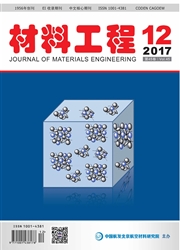

 中文摘要:
中文摘要:
采用化学气相沉积(CVD)法,在SiC纤维表面沉积了100nm厚的C涂层,研究了制备温度对c涂层微观结构、单丝纤维体电导率及纤维编制体介电性能的影响。采用SEM和RAM显微技术(Raman microscopy)对C涂层的表面形貌和微观结构进行分析。结果表明:保持C涂层厚度一致,当沉积温度由800℃升到900℃后,C涂层的石墨化程度提高,晶粒变大,SiC纤维单丝体电导率由0.745Ω^-1·cm^-1升到6.289Ω^-1·cm^-1;SiC纤维编制体的复介电常数实部由90升到132,介电损耗由0.95升到1.14,其中虚部由87升到150。实部增大与载流子浓度增大有关,虚部增大与材料漏导电有关。认为这是SiC纤维表面沉积的C层使纤维电导率增大所致。直流电导损耗是其主要损耗机制。
 英文摘要:
英文摘要:
A carbon coating of 100nm thick was prepared on the surface of SiC fibers by chemical vapor deposition method. The effect of fabrication temperature on microstructure of carbon coating and on the body conductivity, permittivity of carbon-coated fiber was studied. Scanning electron microscopy and Raman microscopy were employed to investigate the surface morphology and microstructure of the coatings. The results show that when fabrication temperature increases from 800℃ to 900℃, the crystallization degree and the grain size of carbon coatings increase and the body conductivity of SiC filament also increases from 0. 745Ω^-1·cm^-1 to 6. 289Ω^-1·cm^-1. The real part of complex permittivity of SiC woven sheet increases from 90 to 132, imaginary part from 87 to 150, respectively,and the dielectric dissipation fraction increases from 0.95 to1. 14 at the same time. The increase of the real part and imaginary part has connection with the increased density of current carrier and missed con- ductivity, respectively. The changes above are attributed to the conductivity increases of the carbon coatings on SiC fibers. The dissipation derived from direct current conductivity is the primary mechanism of the dissipation above all.
 同期刊论文项目
同期刊论文项目
 同项目期刊论文
同项目期刊论文
 期刊信息
期刊信息
